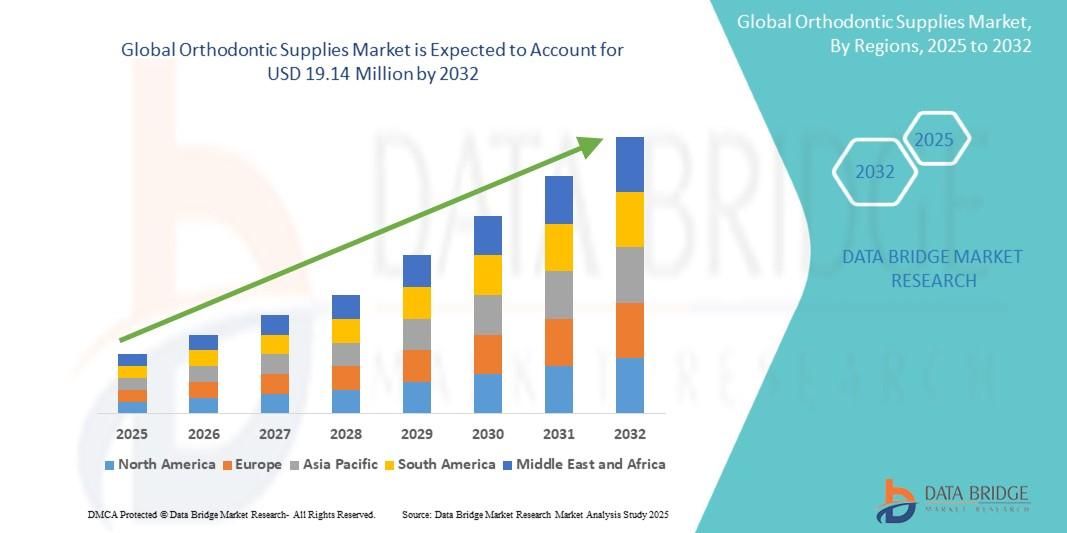Notifications

9 minutes, 3 seconds
-27 Views 0 Comments 0 Likes 0 Reviews

Orthodontics—once a niche subset of dentistry focused primarily on aligning teeth—has evolved into a global industry driven by technology, aesthetics, and increasing demand for non-invasive dental solutions. Central to this transformation is the orthodontic supplies market, which encompasses the diverse range of tools, devices, and accessories required to deliver orthodontic care.
From traditional metal braces and ceramic brackets to clear aligners and 3D imaging systems, the development of orthodontic supplies reflects a broader shift toward personalized medicine, patient comfort, and digital workflow integration. This guest post delves deep into the orthodontic supplies industry, including its key components, technological innovations, market dynamics, regional insights, challenges, and future trends.
Orthodontic supplies refer to the tools, devices, and accessories used by orthodontists to diagnose, plan, and treat malocclusions (improper bites) and dental alignment issues. These supplies include:
Fixed Appliances: Brackets, archwires, bands, ligatures
Removable Appliances: Clear aligners, retainers
Adhesives: Dental bonding agents and cements
Instruments: Pliers, separators, cutters
Accessories: Elastics, springs, headgear
Imaging and Scanning Tools: Intraoral scanners, X-ray systems, cephalometric tools
Together, these supplies support diagnosis, treatment planning, active correction, and retention, forming the backbone of modern orthodontic practice.
Metal Brackets: Traditionally made from stainless steel, offering durability and cost-effectiveness.
Ceramic Brackets: Tooth-colored and aesthetically preferred by adults.
Self-Ligating Brackets: Eliminate the need for elastics, offering smoother movement and reduced chair time.
Available in stainless steel, nickel-titanium (NiTi), or beta-titanium.
Drive the movement of teeth by applying continuous pressure through the bracket system.
Orthodontic bands wrap around molars to provide anchorage.
Buccal tubes are metal attachments that hold archwires or auxiliary appliances.
A revolutionary development offering invisible, removable, and personalized treatment options.
Brands like Invisalign have pioneered this category, with increasing competition from startups and dental labs.
Maintain post-treatment alignment and prevent relapse.
Include Hawley retainers, clear retainers, and fixed bonded retainers.
Used to bond brackets and bands to teeth.
Must ensure high bond strength, ease of removal, and biocompatibility.
Include pliers, cutters, scalers, and separators, all designed to streamline clinical procedures.
Digital radiography, CBCT (Cone Beam Computed Tomography), and 3D intraoral scanners enhance precision and planning.
CAD/CAM (Computer-Aided Design/Manufacturing) systems streamline the design and fabrication of aligners and retainers.
Intraoral scanners replace traditional impressions, increasing accuracy and patient comfort.
AI-driven software can now predict treatment outcomes, simulate tooth movement, and enhance treatment planning efficiency.
Customized brackets, aligners, and models can be produced on-demand.
Reduces turnaround time and allows for mass customization.
Integration of IoT and sensor-based devices to track aligner wear or tooth movement in real-time.
Smartphone apps are increasingly used for compliance monitoring and virtual consultations.
The global orthodontic supplies market was valued at USD 6.5 billion in 2023.
Expected to reach USD 12.1 billion by 2030, growing at a CAGR of 9.1%.
Rising demand for aesthetic and minimally invasive dental treatments.
Increasing incidence of malocclusion and dental disorders.
Growing adoption of clear aligners and digital orthodontics.
Expansion of dental service organizations (DSOs) and corporate dental chains.
North America: Largest market share due to early adoption of technology and insurance coverage.
Europe: Strong growth supported by aging populations and dental tourism.
Asia-Pacific: Fastest-growing region with rising disposable income and expanding healthcare access.
Middle East & Africa: Untapped potential due to urbanization and increasing cosmetic dentistry awareness.
Align Technology, Inc. (Invisalign)
3M Company
Dentsply Sirona
Ormco Corporation
Henry Schein, Inc.
American Orthodontics
G&H Orthodontics
Startups like Candid, SmileDirectClub, and Byte have disrupted the traditional supply chain with direct-to-consumer (DTC) models, supported by teledentistry platforms.
Medical devices, including orthodontic appliances, must comply with FDA, CE, and ISO standards.
Regulatory delays can impede innovation.
Adoption of 3D printing and intraoral scanning can be expensive for small clinics.
Capital investment remains a barrier in emerging markets.
The online dental supply chain has made it easier for low-cost, substandard products to enter the market.
Brand reputation and safety are critical concerns.
The shift to digital orthodontics requires upskilling of practitioners.
Lack of technical proficiency can impact treatment quality.
Advances in genetics, digital imaging, and AI will drive truly customized orthodontic treatment plans.
Patients increasingly expect faster, more comfortable, and invisible options.
Virtual consultations, treatment tracking, and remote monitoring have accelerated post-COVID.
DTC aligner companies are leveraging teledentistry for mass outreach.
Growing awareness of sustainability is prompting interest in:
Biodegradable aligners
Reusable materials
Environmentally friendly packaging and sterilization
Early intervention using smart diagnostics aims to reduce the duration and complexity of later treatments.
Preventive devices like myofunctional appliances are gaining traction.
In the U.S., orthodontic devices are regulated under FDA Class II devices.
The European Medical Device Regulation (MDR) governs product quality and CE marking.
Compliance with ISO 13485 ensures the quality management systems for manufacturers.
Ensuring compliance is essential for product safety, market access, and consumer trust.
The integration of genomic data, lifestyle habits, and facial structure analytics could lead to fully personalized orthodontic pathways.
Companies may offer aligner-as-a-service or monthly subscription plans that include regular checkups, replacements, and virtual support.
Platforms may soon auto-generate entire treatment plans, including bracket positioning, force mapping, and retention strategies, based on historical success models.
The democratization of orthodontic care through mobile units, teledentistry, and DTC kits will expand access in underserved regions.
Orthodontic supplies have come a long way from basic metal brackets to intelligent, patient-friendly, and digitally optimized solutions. The industry stands at the crossroads of healthcare, aesthetics, and advanced engineering, making it one of the most exciting frontiers in modern dentistry.
As technology continues to evolve, the orthodontic supplies market will increasingly prioritize efficiency, precision, and personalization. For stakeholders across the ecosystem—clinicians, manufacturers, investors, and patients—this presents an incredible opportunity to shape the future of smiles, one innovation at a time.
Whether you're a practitioner looking to modernize your clinic or an entrepreneur entering this high-growth space, the time to embrace the orthodontic revolution is now.

